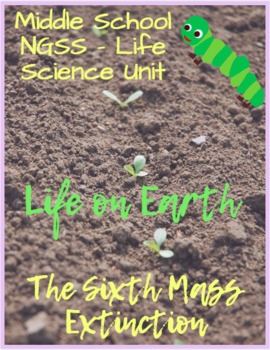Life Science UNIT for Middle School
- Zip
Also included in
- Are you a middle school Science teacher using Next Generation Science Standards? Do you want your students to work harder than you?Are you wanting to use more inquiry in your classroom? Are you ready to challenge your students with project-based tasks to show their learning?Grab this bundle now!WhatPrice $105.00Original Price $127.65Save $22.65
Description
This is an all-inclusive inquiry based, student-centered unit on Life on Earth.
When you buy this bundle, you will gain:
- 8 student activities
- 1 teacher document
- 1 unit teaser document
- 1 unit rubric
- 1 presentation with class starters
- suggested unit timeline
- Directions to help implement this inquiry unit
-------------------------------------------------------------------------------------------------------------------------------
Unit Story: Due to Earth’s resources being depleted, the majority of the human population is relocating to Mars. You are part of a team that has been designated to stay behind and make Earth livable again.
_________________________________________________________________
Unit Task: As one of the few scientists staying behind on Earth, you must determine a strategy for how to rebuild Earth, determine criteria that people must follow to recolonize Earth, and create a model of what houses will need to look like.
Topics Covered:
1. The 5 Big Mass Extinctions
2. Fossil Record
3. Evolution
4. Natural Selection
5. Environmental Factors
6. Natural Resources
7. Human Impact on Earth
__________________________________________________________________
NGSS Middle School Science Standards covered:
- LS3-1 - Develop and use a model to describe why structural changes to genes (mutations) located on chromosomes may affect proteins and may result in harmful, beneficial, or neutral effects to the structure and function of the organism.
- LS4-1 - Analyze and interpret data for patterns in the fossil record that document the existence, diversity, extinction, and change of life forms throughout history of life on Earth under the assumption that natural laws operate today as in the past.
- LS4-2 - Apply scientific ideas to construct an explanation for the anatomical similarities and differences among modern organisms and between modern and fossil organisms to infer evolutionary relationships.
- LS4-3 - Analyze displays of pictorial data to compare patterns of similarities in the embryological development across multiple species to identify relationships not evident in the fully formed anatomy.
____________________________________________________________________
Struggling to know how to introduce inquiry into your classroom? Check out this post
or take this 6 module video course
__________________________________________________________________
Want to know about discounts, freebies and new products?
Find the green star next to my store logo and click it to become a follower. Yeehaw!
You are ready to be Challenged by a Teacher Mom - be on the lookout for email updates about this store.
__________________________________________________________________
All rights reserved 2017 Challenges from a Teacher Mom




